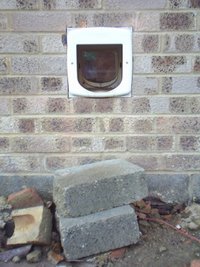 A cat flap in action.
A cat flap in action.
|
From Wikipedia the free encyclopedia, by MultiMedia |
 A cat flap in action.
A cat flap in action.
A cat flap (also known as a doggie door or pet door) is a hinged flap set into a door, wall or window to allow cats, dogs, or other domestic pets to enter and exit a house on their own without needing a human to open the door. They are very popular with cat owners, many of whom like to encourage their cats' natural independence by letting them come and go at will — particularly in the United Kingdom where it is believed that about 90% of all cats (including ferals) have access to the outdoors, many of these via cat flaps ([1]). Flaps for most dogs must be bigger and therefore are often constructed differently; except in rural areas they tend to give access to fenced-in yards or gardens rather than the neighborhood at large.
The simplest are just weighted flaps, but these can have problems with wind blowing open the flap or making a rattling noise. A magnet on the flap addresses this issue by holding the door in place when not in use, but not so securely as to prevent access. Sometimes a flap will also have adjustable catches to restrict the opening of the flap in one direction or the other — for example to allow the animal to come in, but not go out again. More sophisticated flaps have electromagnetic catches that can detect a matching permanent magnet worn on the animal's collar and unlock the flap as the animal approaches, thus preventing any other animals using the flap to enter the house.
Devotees suggest a pet door should be set at a height so that the bottom of the opening is just a little lower than the belly of the animal when standing. Many animals prefer to use a flap with a transparent flap, so that they can be sure there is nothing threatening outside before leaving the safety of the home.
 A wall-mounted flap with access tunnel.
A wall-mounted flap with access tunnel.
The invention of the cat flap is often attributed to Sir Isaac Newton in the seventeenth century; this story, however, is usually related ([2], for example) without any sources to support it.
Cats, made by MultiMedia | Free content and software
This guide is licensed under the GNU Free Documentation License. It uses material from the Wikipedia.